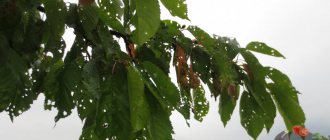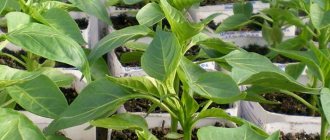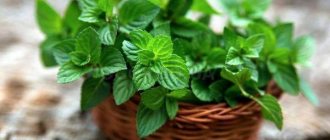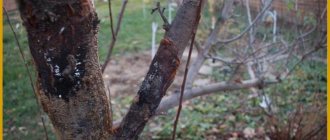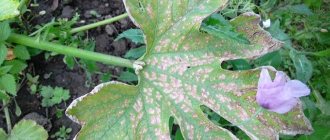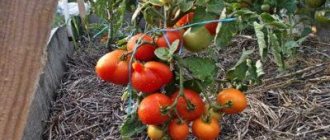Home / Vegetable garden / Tomatoes
Back
Published: 06/16/2019
1
Rate this post
The microclimate created inside greenhouses helps protect tomatoes from cold, drought, and bad weather, but no greenhouse or greenhouse can provide complete protection from diseases. Even worse, if the rules for caring for greenhouse tomatoes are violated, the proliferation of pathogenic microorganisms is activated. If you have already decided to acquire a greenhouse, then get ready to impeccably follow all the rules for caring for the crops that you intend to grow.
- 1 Causes of pathogenic microorganisms
- 2 Late blight
- 3 We fight fungi
- 4 Brown spot
- 5 Fighting brown spot
- 6 Tomatoes resistant to cladosporiosis
- 7 Mosaic
- 8 Fruit cracking
- 9 White plaque
- 10 Black Leg
- 11 Leaf mold
- 12 Macrosporiosis
- 13 Powdery mildew (ashtray, white)
- 14 Yellow curl
- 15 How to get rid of frizz?
- 16 Stem necrosis
- 17 What is required from a gardener
- 18 Preventive measures against diseases of greenhouse tomatoes
Causes of pathogenic microorganisms
Spores of pathogenic microorganisms, as well as insect larvae, can survive the harshest winter in unheated greenhouses. With the advent of comfortable conditions, both immediately begin their destructive activity for tomatoes.
Tomatoes in greenhouses can get sick, even if you completely replaced the soil before sowing. This happens if they took seedlings for growing, that is, they initially planted already diseased tomatoes.
No matter how tightly we close the greenhouses, insects still get inside and bring infection with them.
The danger of disease accompanies greenhouse tomatoes from the day the seeds are sown until the fruit is harvested. Treatment is complicated by the fact that flowering tomatoes cannot be treated with chemical protection agents. The flowering period is a favorable time for the proliferation of pathogens and parasitic insects. How many diseases there are can be seen from the photo.
Now you understand how important preventive measures are for tomatoes in a greenhouse.
Tomatoes in bloom can be treated for diseases using folk remedies. This is the addition of wood ash, dolomite flour or quicklime to the soil. In addition, if you water the soil with a milk solution, late blight will bypass the tomatoes. A very weak saline solution has a similar effect. Garlic infusion protects plants from fungal diseases. An infusion of onion peels provides the same effect.
When choosing tomatoes for growing in greenhouses, give preference to those varieties that are highly resistant to fungal diseases. Descriptions with photographs will help you understand tomato diseases and the fight against them.
Greenhouse pests of tomatoes with photos and descriptions
For many insects, tomatoes are a source of food and habitat. They harm plants and destroy crops. Many insects are carriers of infections. Pests transfer pathogenic microorganisms on their bodies from infected bushes to healthy ones. This leads to massive crop loss. Tomato pests can be controlled with chemicals and folk remedies.
You can prevent the appearance of insects by creating a favorable microclimate in the greenhouse. High humidity and air stagnation should not be allowed. It is not recommended to plant bushes too often. It is imperative to ventilate the greenhouse.
Medvedka
This insect is the largest of those living underground. The body length of the mole cricket reaches 10 cm. The pest prefers loose, warm soil and is often found in greenhouses. This insect is omnivorous and can completely destroy a tomato crop. You can recognize the presence of a mole cricket by the following signs:
- damage to the root system of plants;
- burrows next to bushes;
- egg laying at a depth of 10-15 cm;
- larvae in the soil.
To destroy mole crickets, soapy water, pepper infusion, vinegar solution, and onion broth are poured into their burrows. If there are a lot of insects, chemicals help: Medvetox, Grizzly, Thunder.
Advice!
You can scare away mole crickets by planting strong-smelling plants in the rows. When planting, peeled garlic, fish, and pine needles are placed in the holes.
Wireworms (click beetle larvae)
Caterpillars look like worms. They have a dense, rigid body up to 3 cm long and powerful jaws. Wireworms feed on the roots of greenhouse tomatoes. If they are not destroyed, the plants wither and die. You can prevent the appearance of wireworms in the greenhouse if you sow the bed with green manure after harvesting.
If insects have already appeared, they are collected using simple traps. Potatoes are buried in the area where the larvae accumulate. Pests get into it. After a few days, the tuber is removed along with the larvae. Chemical preparations that work effectively: Kapkan, Provotox, Zemlin, Bazudin.
Whitefly
Small moths are considered one of the most dangerous for tomatoes. They hide on the back of the leaves and lay eggs there, which feed on the sap of the plant. Adults feed on plant tissues and transmit infection from one bush to another.
If there are few whiteflies, folk remedies are used to combat them: soap solution, ash, ammonia solution. When there is a large concentration of insects, the following chemicals are effective: Tanrek, Iskra, Biotlin. The preparations are applied precisely to the back of the leaves to completely destroy the insects. Whiteflies quickly adapt to the action of insecticides, so they need to be alternated to achieve maximum effect.
Spider mite
These pests are very small. It is impossible to see them with the naked eye. They settle on the underside of leaves and feed on plant sap. You can recognize a spider mite infestation by small orange spots on the leaves and a thin web between the veins. The infected plant withers and gradually dries out.
To destroy spider mites, use the drug Fitoverm. This product does not harm plants and is safe for humans. If the affected area is small, traditional methods are used: spraying with soap solution, garlic water, dandelion or tobacco infusion. The chemicals used include Karbofos, Antiklesch, and Agravertin.
Root-knot nematode
Small roundworms feed on the roots of tomato plants. Their presence can be recognized by characteristic growths in the form of warts on the underground part of plants. Tomatoes infected with nematodes quickly wilt during the day, but by evening the leaf turgor is restored. After 10-15 days the bushes die. These pests are carriers of dangerous infections.
Late blight
Late blight is the most common disease of greenhouse tomatoes. The disease is caused by the activity of fungal spores. These microorganisms need high ambient humidity, which is almost always the case inside greenhouses. In garden beds, natural air circulation does not allow spores to awaken; in greenhouses, this can only be achieved with good ventilation. The appearance of dampness in a greenhouse is always accompanied by the awakening of fungal spores.
Also, fungal diseases of greenhouse tomatoes occur due to sudden changes in day and night temperatures. This phenomenon is observed in the spring, when air temperature fluctuations occur within 10-15 degrees.
Late blight is manifested by the appearance of ugly brown spots on the leaves and fruits. The leaves curl into tubes, the bush withers and dries up.
We fight fungi
Increased humidity leads to the development of diseases. To avoid fungal diseases of tomatoes, equip a polycarbonate greenhouse with a drip irrigation system. It minimizes the evaporation of moisture from the soil, thereby maximizing the level of air humidity inside the greenhouses.
There is a simple but quite effective way to create such an irrigation system. To do this, stick a regular plastic bottle with the neck into the ground under each bush and cut off the bottom. When watering, pour water into each bottle, and it will be used up very slowly. In fact, the top layer of soil may even remain dry.
An effective way to prevent late blight is to spray tomato bushes with whey weekly. The acid it contains kills fungal spores.
How to spray tomatoes against infection? You can use “Barrier”, “Fitosporin” or “Barrier”. All solutions are chemicals, so they should not be abused. Use them according to instructions.
Excessive use of fungicides on tomatoes will deplete the soil in the greenhouse. Even worse, the pulp of the fruit becomes saturated with harmful substances. It is highly undesirable to eat such tomatoes. It is for these reasons that many gardeners use only environmentally friendly means of preventing late blight - folk ones.
Of course, their effect is not as powerful as that of chemical ones. It often happens that you simply cannot do without chemistry. Then it is better to use phytosporin. This drug is the least harmful to the soil, but successfully copes with late blight, late blight, Alternaria, and black spot in the greenhouse. Moreover, phytosporin cannot be called a classical chemical drug; it is rather microbiological. It contains live bacteria that help strengthen plant immunity.
It turns out that when tomatoes are treated in a greenhouse with phytosporin, they themselves begin to fight fungal and other diseases. After spraying the bushes with fruits, you can enjoy them even the next day. This drug does not have a toxic effect on them. Of course, the tomatoes need to be washed thoroughly and only then served.
Fitosporin is produced in the form of a paste or powder. It can be used at any stage of tomato development.
By the way, the tomato variety for greenhouses “Tatyana” is resistant to late blight.
Brown spot
Experts call this disease cladosporiosis. The disease manifests itself with the appearance of round yellow spots on the lower leaves of tomatoes - as in the photo. If treatment is not done in time, these spots begin to increase. Fungal spores then appear on the underside of the leaves. They look like a brown coating with a velvety surface.
Soon the leaves begin to dry out, which invariably leads to the death of the plant. The sad thing is that brown spot usually occurs during the flowering and fruiting period of tomatoes, when chemical protection cannot be used. If the air humidity in the greenhouse is too high and the lighting is not bright enough, the crops may die in a matter of days.
Fungal spores are amazingly resilient. They are able to wake up after tens of thousands of years of hibernation and begin their destructive activities, as if they had just been born.
At the early stage of the disease, chemical remedies should not be used. It is better to remove the affected parts of the plant and treat the bushes using traditional methods.
Septoria, white leaf spot
Septoria blight
Septoria blight, white leaf spot, is a fungal disease. Reduces yield, causing premature drying and leaf fall. The lower leaves become diseased first. First, single rounded small light spots appear. The center of the spot is gray-white, and the edges are slightly darker. Then a black dot appears in the middle of the spot. The disease first affects the leaves, then the petioles and stems. After some time, the leaves turn brown and then fall off. High humidity and warm weather contribute to the rapid spread of the disease. The harmfulness of septoria increases in the second half of summer.
Septoria blight is not transmitted by seeds.
Treat with copper-containing preparations, for example, Zineb, Horus, copper oxychloride. The earlier the better. It is advisable to remove the affected leaves at the very beginning of the disease, even if only the growing point at the tops of the stems remains.
Fighting brown spot
How to deal with this tomato disease in a greenhouse? It would be a good idea to prepare a whey solution - one liter per bucket of water. Spray the bushes with this solution. This method is effective in preventing fungal diseases of tomatoes.
Another method of treatment: dissolve 15 drops of iodine in half a liter of fresh heated milk, mix this solution with five liters of warm water. Spray the bushes with this product and treat the affected areas on the underside of the leaves. The main thing is not to leave a single point of brown plaque on them.
How else can you treat bushes in a greenhouse against disease? It will be absolutely harmless for tomatoes and you if you spray the bushes alternately with a solution of potassium permanganate and a decoction of wood ash. The interval between spraying is at least a week.
The color of the manganese solution should be pink. To prepare the decoction, take 300 grams of ash and boil it in a small amount of water. After boiling, leave the broth on low heat for 20 minutes to simmer. Then dilute the substance in ten liters of water and spray the tomatoes with it.
Chemical means to combat brown spot - copper oxychloride, one percent solution of Bordeaux mixture, Integral, Pseudobacterin 2, Fitosporin M.
Green and yellow spots on tomatoes - tomato mosaic
In tomatoes affected by this disease, a characteristic mosaic pattern appears on the tops in the form of alternating green and yellow spots. In young leaves, the mosaic pattern is more clearly visible than in older leaves. The disease spreads very quickly to nearby tomato bushes. In the future, yellowish spots may appear on the fruits. This is tomato mosaic , a viral disease. The virus is transmitted by insect pests in the soil, but first of all, infection occurs with seeds. Therefore, to prevent mosaic, it is necessary to choose seeds of hybrids that are immune to this virus. If there is no data on the variety’s resistance to mosaic virus, then the planting material must be pickled in a 1% solution of potassium permanganate for 20 minutes.
Plants affected by mosaic are not treated , but are removed from the site and then destroyed.
Tomatoes resistant to cladosporiosis
Breeders have developed more than two dozen varieties of tomatoes with increased resistance to cladosporiosis. Our gardeners willingly grow wonderful “Nasha Masha F1” tomatoes in greenhouses. They are resistant to fungal diseases and very tasty. The Belarusian variety “Vezha” is no less popular, although its fruits are slightly smaller.
The varieties “Delicacy” with pink fruits and “Space Star F1” ripen well in greenhouses. For the sake of prevention, it is advisable to spray the latter with the drug “Alirin-B” or “Gamair”.
Separately, it is worth mentioning the tomatoes “Funtik” and “Evpator”. Their raw fruits are not so tasty, but these high-yielding varieties are very suitable for processing. They are the ones who most powerfully resist fungal diseases. These diseases happen to them very rarely.
Mosaic
This is the most terrible disease that affects greenhouse tomatoes. In addition, scientists have not yet invented a cure for mosaic. The causative agents of the disease are viruses. That is why it is important to carry out all preventive measures against this disease.
Mosaic manifests itself by the appearance of small light and dark green spots on the leaves. Soon they begin to increase in size and form entire mosaic islands. At the first manifestation of one of these signs, immediately tear the bush out of the ground and burn it, because the spread of infection is inevitable. Be sure to disinfect the place where it grew with a strong drug.
White plaque
White coating on the leaves occurs due to plant rot. There are four types of this disease (shown in the photo).
- Root rot. This is rotting of the roots of the plant. The disease occurs due to improper soil preparation for planting. Most often, root rot appears when there is an excess of insufficiently rotted manure in the soil, with excessive watering or poor or absent drainage.
- Apex rot. This disease does not affect the tops, but only affects the fruits of tomatoes. It appears as spots on tomatoes. The cause of the disease is improper care of tomatoes: violation of watering rules or excess nitrogen fertilizers.
- Gray rot occurs from stale air in a greenhouse with high humidity. Signs of gray rot are visible by wet gray spots on the stems and leaves of the plant. If treatment is not started on time, then soon foci of sporulation will appear on the bush - an ash-gray coating. This disease also occurs when there is poor ventilation in the greenhouse or high humidity. It’s up to you to decide what to do, use chemicals or folk remedies.
- Brown rot appears only on the stalks and fruits. The source of the disease looks like a small speck. In this case, the middle of the fruit almost completely rots. The cause of brown rot is fresh manure. It cannot be used in polycarbonate greenhouses.
An excellent preventive measure against rotting tomatoes in a greenhouse is to periodically spray the bushes with garlic infusion or sprinkle them with wood ash.
Watery black-brown spots on leaves
Do dark, watery spots of irregular shape appear on the lowest leaves or on the stem? Apparently, late blight (brown rot of tomato fruits) has come to us. A very dangerous fungus because it affects leaves, stems, and fruits. If late blight has raged, nothing can overcome it. Therefore, it is important to notice symptoms as early as possible and slow down the progression of the disease as much as possible.
How it manifests itself:
Tomato tops become covered with black-brown spots. Over time, they merge with each other, quickly grow, enveloping the tissue in a ring. Because of this, the top of the bush, along with the growing point, dies. Green fruits turn brown and are unsuitable for food.
Conditions for active development:
The pathogenic fungus actively penetrates plant tissues during sudden temperature changes. Moderately warm days, cold nights, dew or daily rain are ideal weather conditions for the development of late blight. But as soon as the humidity drops to 75% and the thermometer reaches 26°C, the growth of infection stops.
What to spray:
Biological products: Alirin-B, Gamair, Trichodermin. Chemicals: Ridomil Gold, Quadris, Profit, Thanos, Revus, Acrobat MC, Strobi. Along with spraying, carefully (so that the spores do not fly away) remove the affected leaves.
We wrote about the prevention and control of late blight in detail in the articles: Preparations for late blight: how to spray diseased plants Fighting late blight: preventive measures and folk remedies
Leaf mold
Most often, this disease manifests itself during the flowering of tomatoes. A signal of leaf mold is the appearance of light green spots on the upper surface of the leaves. If immediate action is not taken, these spots will soon turn yellowish-white. Then the affected leaves begin to turn yellow, curl into tubes and fall off.
To prevent the occurrence of this disease, disinfect greenhouses, and before each planting of tomatoes, change the top layer of soil to a depth of at least 30 cm. Ventilate the greenhouse well daily. Treat the seeds before planting.
If the disease does occur, then you can try to save the tomatoes using the drug “Zineb Suspension” or its analogues.
Macrosporiasis
Gardeners usually call this disease dry spotting. Macrosporiasis manifests itself by the appearance of oblong brown spots on the leaves, stalks, petioles and stems of the plant. Further spots appear on the surface of the fruit. Infection also occurs due to stale air in the greenhouse and high humidity. At low ambient temperatures, the disease begins to progress sharply.
At the first manifestations of foci of the disease, remove the affected parts from the bush and burn them. If a significant part of the bush is affected by such spots, then there is no point in saving the plant. Pull the bush out of the ground by the roots and burn it. Treat the soil in the greenhouse underneath with special preparations. However, Bordeaux mixture is quite suitable for this.
Dry concentric brown spots on tomato leaves
Do the spots on tomato leaves resemble annual rings on the stump of a cut down tree? Most likely, your garden bed is dominated by dry spotting, scientifically called Alternaria blight or macrosporiosis. It affects both adult plants and seedlings, especially overgrown ones.
How it manifests itself:
Along with leaf spot, this disease can appear as ring-shaped black spots on the stems. The spots crack and the stem begins to rot. The progress of the disease leads to the fact that the leaves dry out, the stem breaks, and the fruits become stained and crack.
Conditions for active development:
The infection usually begins and continues in moderately warm weather (August). Rain, wind, heavy dew contribute to its development. By the way, the pathogenic fungus can be introduced into the garden with irrigation water. The ideal temperature for Alternaria is from +13°C to +16°C.
What to spray:
Fungicides will help us in the fight against macrosporiosis: Poliram DF, Acrobat MC, Infinito, Kuproksat.
Powdery mildew (ashtray, white)
According to the description, the disease destroys the immune system of tomatoes. Powdery mildew feeds exclusively on plant sap, thereby depriving them of nutrients. The first appearance is found on tomato leaves as a white coating - this can be seen in the photo. Affected leaves quickly wither and fall off.
At the same time, new leaves form on the stems from dormant buds, but they are extremely weakened. Without taking proper measures, the bush in the greenhouse soon loses its resistance to any diseases and dies. They get rid of powdery mildew mechanically, followed by treating the bushes with protective drugs.
Yellow curl
The causative agent of yellow curl is the virus of the same name. It is carried by whiteflies and aphids. The sad thing is that this disease can occur at any stage of tomato development. Even a weak form of yellow curl entails a yield loss in the greenhouse of at least 15 percent. If the disease is not defeated in time, the entire crop will die.
Yellow curl is manifested by a change in leaf color from green to light yellow. In this case, light yellowness may cover only the edge of the leaf. The rest of it remains dark green.
The word “curly” is present in the name of the disease for a reason. The leaves on the tops of the affected tomato bushes actually become curly and decrease in size. Bushes affected by yellow curl grow very slowly, and flowers often fall from them. Worse, the resulting fruits stop gaining weight and remain small forever. Their flesh turns out to be excessively dense, and their shape is ribbed.
How to get rid of frizz?
Let’s say right away that it is impossible to cure a bush affected by yellow curl. It needs to be removed. But it is quite possible to protect the greenhouse from this disease. You probably already guessed that you should take preventive measures against whiteflies and aphids, which are the ones that transmit the yellow curl virus. Main -
immediately destroy these parasites upon first detection. To do this, you should use the drugs “Aktara”, “Iskra” or “Aktellik”.
You must clearly understand that you need to ventilate the greenhouse daily and never allow the air humidity to rise to 80%. Higher humidity will definitely lead to diseases.
Perhaps it is worth mentioning a wonderful remedy for combating whiteflies - “Farmayod”. The bushes should be treated with this product at intervals of 10 days during the butterfly flight.
It is noteworthy that ground tomatoes are practically not susceptible to yellow curl, but greenhouse tomatoes are the opposite.
Fungal diseases
Fungal microorganisms have increased vitality. They can withstand heat and cold very well. They are successfully preserved in the soil during severe frosts, and in the spring they attack the crop with renewed vigor. When fighting it, special attention is paid to soil disinfection.
Late blight
Late blight is a common disease of garden crops, especially dangerous for tomatoes. The word “late blight” itself means “destroying a plant.” There are 50 types of pathogens of this disease. Dealing with them is difficult, but possible.
The first rule is to carefully monitor the condition of the plants, starting in mid-summer. Late blight is manifested by blackening of the leaves, then the fruits. The inflorescences turn yellow and fall off, preventing fruit from setting. Within a couple of days, all plants in the greenhouse are affected. Therefore, it is important to notice the disease in time and begin to treat it. Pay attention to the photo.
Traditional methods
Fight with home remedies:
- Spray with whey diluted with water 1:1, sometimes replaced with kefir. Then the solution is prepared from the ratio: 1 liter of kefir per 10 liters of water. Used every day for both prevention and treatment purposes.
- Another handy remedy is baking soda. 2 tbsp. l. dilute soda in 10 liters of water and add a little liquid soap so that the solution sticks to the leaves. For a visible effect, treat plants every week.
- Salt is used for prevention: 250 g are diluted in 10 liters of water. After drying, the salt forms a small film on the surface of the leaves and stem, thanks to which late blight does not penetrate deep into the plant.
Chemical methods
If folk remedies no longer help, use chemistry:
- Spray with fungicide “HOM”: dilute 40 g per 10 liters of water. True, the drug is aimed more at prevention than treatment. But there is a significant advantage: the substance does not accumulate in the soil and plants, which means it is not addictive. It is used up to five times per summer. Maintains defense for up to two weeks, but is washed off by rain.
- Treat with antibacterial “Furacilin”: 10 tablets are crushed and diluted in 10 liters of water. Prepare immediately for the entire summer season. Apply three times during the summer.
- Treat with biological pesticide “Fitosporin”: 2 tsp. for 10 liters of water. The drug is safe for humans, penetrates plant tissue and kills pathogenic bacteria. After use, the fruits can be eaten immediately. Plants are treated every 10 days.
Attention! If tomatoes and potatoes are planted next to each other, process them together. Often late blight immediately affects potatoes, tomatoes, eggplants and cucumbers in one area.
PHYTOPHORA ON TOMATOES - ENEMY No. 1. [An effective way to fight.]
Cladosporiosis
Cladosporiosis is a fungal disease characterized by brown spots on seedlings. It is practically untreatable, since the fungus that causes the disease can survive under unfavorable conditions (even in winter) for up to 10 months.
When a gray coating and brown spots form on the leaves, it’s time to sound the alarm. Even one infected tomato bush can cause the death of the entire seedling. The disease does not affect the stems and fruits, but completely deprives the plant of its greenery. What affects the fruits: they do not ripen, shrink and begin to rot.
Completely affected bushes are removed from the greenhouse or greenhouse. If signs of damage are just beginning to appear on the plants, then there is a chance to compete for the harvest.
Traditional methods
Such methods will not help with the progressive stage of the disease, when the plant already has brown spots.
- Whey comes to the rescue: 1 liter per 10 liters of water. The solution is suitable for spraying.
- To disinfect the soil, potassium chloride is used: dissolve 30 g per 10 liters of water and 40 drops of iodine. The soil is soaked to a depth of at least 10 cm.
- If the soil is acidic, then a decoction of wood ash will help: boil 300 g of ash in 10 liters of water for 25 minutes, then leave for two days.
Chemicals
In the later stages of the disease and severe damage to the bush, chemicals are used. For treatment, broad-spectrum fungicides are used: “HOM”, “Poliram”, “Abiga-Pik”, “Bravo”, “Ditan NeoTek 75”. They are processed late in the evening, when there is no hot sun, wind or rain, a month before harvest. Repeat every two weeks. The products are diluted according to the instructions for use, observing the specified precautions.
Anthracnose
Another of the most common fungal diseases of tomatoes is anthracnose. Affects all areas of the bush . On leaves and stems it appears as reddish-brown spots with a yellow border along the edge. Then they turn purple, darkening and rotting.
Round, “pressed-in” spots appear on the fruits, which also grow over time and begin to darken, acquiring a black color. As a result of damage to the root system, the bushes themselves do not grow intensively, they curl, the leaves turn yellow and fall off, the ovaries do not form or crumble.
Mature tomatoes are more often affected. Moreover, the disease mainly affects fruits that touch the ground. At the top of the bush, the fruits remain uninfected.
Tomatoes affected by anthracnose cannot be saved. Affected bushes are dug up and burned. Treatment is carried out at the first symptoms of the disease and treated for prevention.
Traditional methods
When a disease is detected, pharmaceuticals are first used:
- They save the crop with the help of copper oxychloride: 40 g of the product are dissolved in 10 liters of water.
- Spray the bushes with 1% Bordeaux mixture or colloidal sulfur.
Chemicals
Special substances for combating fungus are the most effective, but harmful to humans and animals:
- Product "Polyrama". It is processed at a consumption of 2.53 kg per hectare. 2-3 procedures are carried out with an interval of 10 days.
- The fungus adapts to medications, so the drugs are changed from time to time. Cumulus DF does a good job. It is suitable for treating tomatoes. Use according to instructions.
- More gentle means help to slow down the spread of anthracnose: “Gamair” and “Fitosporin-M”. The method of use is described in the instructions.
SUPER MIXTURE No. 1-c for TOMATOES and CUCUMBERS from PHYTOPHORA, ANTHracnose, PERONOSPORASIS + FEEDING
Stem necrosis
Tomatoes and potatoes suffer from this bacterial disease. The disease occurs at the beginning of fruiting. Pseudomonas, the causative agent of the disease, is spread by seeds. Subsequently, the bacteria are transferred to other bushes - with streams of irrigation water, even with the help of the wind.
Stem necrosis is an insidious disease, since it does not manifest itself for a long time. It is known for certain that the incubation period lasts 18 days. The first symptoms of the disease are found on the tallest bushes at the time of the birth of the first cluster.
An elongated, slightly depressed brown spot appears on the lower part of the stem, under which bacteria rapidly multiply in the tissues of the stem. Under pressure from a growing colony of microbes, the stem cracks and a cream-colored liquid flows out of it. This substance is full of pathogenic bacteria.
If you cut the stem of an affected plant lengthwise, you will see that its core seems to have become glassy. Subsequently, it dries completely and becomes almost black. It is amazing that fruit development continues on the affected bushes. Light veins appear on their surface, which do not disappear after full ripening. If you shake a bush affected by stem necrosis, the tomatoes or flowers will begin to fall off.
The tricky part of the disease is that the infection persists in the tomato seeds. True, affected seeds can be easily distinguished from healthy ones by their deformation and the presence of dark spots. Burn such seeds. Affected fruits should not be eaten!
If treatment is not started, the tops of diseased bushes will begin to darken and lose turgor. Soon the entire bush will wither and die.
Bacterial diseases
Tomato harvest can be lost due to the following diseases:
Stem necrosis
This disease affects tomatoes during the fruiting period.
A characteristic symptom is the appearance of small ulcers on the stem of the plant. They will quickly begin to darken and the stems will crack. If you press on this place, white mucus is squeezed out.
At the next stage, the leaves throughout the bush begin to dry out. The duration of the disease is up to 3 weeks. After this period, the plant dies. To protect all seedlings, it is advisable to immediately remove the affected specimen.
How to save the harvest?
- Stem necrosis is stopped with a solution of potassium permanganate: 15 g. PC is dissolved in 10 liters of water for watering the soil.
- Among the chemical agents against stem necrosis, “Fitolavin-300” with water is effective.
Bacteriosis
This disease is striking in its speed of spread. You can leave your plants in perfect order in the evening, and in the morning find the bushes completely withered. If you cut the affected stems, you may find liquid or emptiness inside. Infected plants must be immediately removed from the greenhouse and burned. The ash of such plants must also be destroyed. It cannot be used as a fertilizer, since the bacterial strains are tenacious.
Treatment:
- Bacteriosis can also be successfully treated with a solution of potassium permanganate. Another option is to dilute a bottle of “Streptomycin” in 10 liters of water, add 15 liters of quicklime vinegar and spray the plants.
What is required from a gardener
An inexperienced eye will not even notice that the plant has been sick for a long time. Inexperienced gardeners usually look at the fruit rather than at the leaves or stems of the plant. Meanwhile, in the initial stage of the disease, many aerial roots appear in the lower part of the bush - a signal that the bush is sick. An experienced eye will see this signal much earlier, when the first cracks appear in the lower section of the trunk, at a height of about 20 cm from the soil surface.
Unfortunately, there are no ways to combat this disease during the growing season. The sooner you detect the disease, the sooner you remove the bush along with the clod of earth, the greater the chance of saving the remaining bushes in the greenhouse.
Sprinkle the area where the diseased bush grew with bleach or pour it with Fitolavin-300 solution. Prevention against this disease is careful sorting and dressing of seeds. The causative agent of stem necrosis dies in a weak solution of potassium permanganate, heated to 40 degrees Celsius.
Breeders have not yet developed a tomato variety that is resistant to stem necrosis. There is only one tomato variety that somehow resists this disease - the Red Arrow hybrid. However, it does not have absolute resistance to this disease.
What do tomatoes “prefer” to get sick in in the open ground?
An interesting fact is that infusions and decoctions are made from tomato leaves and sprayed on plants, protecting them from the invasion of aphids and caterpillars, as well as from other pests that gnaw on the leaves of garden crops.
But as practice shows, despite all the miraculous properties, the tomatoes themselves are exposed not only to various pests, but also to a large number of diseases that can destroy not only the fruits, but even the sprouts of seedlings, reducing the future tomato harvest to a minimum. Disease and pest control is a very important aspect of quality care for tomatoes grown in open ground.
Each open ground tomato disease has its own characteristic signs and its own control measures. Diseases of tomatoes in the soil and their treatment need to be known to every gardener who wants to grow a decent harvest of this vegetable.
Late blight is the main threat to all tomatoes
Late blight is already mentioned when considering “greenhouse” diseases, the most famous and common fungal disease , which most often affects late varieties of tomatoes .
Initially, potato leaves become infected with this disease, and then the fungus spreads to tomato plants in open ground.
This fungal disease develops most actively and intensively in cool and damp weather conditions. But the fungus develops for quite a long time and appears on leaves and fruits no earlier than August. Thanks to this, early ripening fruits are not susceptible to this disease. What are the first symptoms of such an open ground tomato disease:
- As soon as the fungal disease touches the leaves or stem of the tomato, the plant begins to change in appearance. The affected areas begin to change color - they become black or brown.
- When the disease begins to develop, it begins to appear even on green tomato fruits. Dark spots form on the leaves and fruits, soft to the touch. If nothing is done, the spotting will only intensify and affect the entire fruit and leaves.
- Over time, damaged leaves turn black, dry out, curl and fall off. The fruits also die.
The first signs of late blight are a signal for immediate action. There is more than one special fungicidal drug that can be used to effectively combat diseases of this category. A properly selected drug will help destroy the fungal disease and prevent this tomato disease from affecting the remaining healthy plants.
If no drug is available for use at the moment , then you can prepare an effective remedy at home. To do this, prepare a solution of table salt and water and spray all the tomatoes. For 1 liter of water you need to take 10 grams of salt. But this solution only helps in the initial stages of the development of this tomato disease . If the problem begins to grow in scale, then the vegetable must be treated using a fungicidal preparation with enhanced action.
The spraying procedure must be carried out at least twice.
If the disease has already occurred, then it is extremely necessary to apply timely treatment. But the occurrence of this problem can be prevented if preventive measures are taken:
- The cultivation of garden crops must be carried out under certain conditions. For example, you should not plant potatoes and tomatoes close to each other.
- The area chosen for planting tomatoes - seedlings or seeds - needs to be dug up well.
- For preventive purposes, you should regularly treat the leaves and the entire length of the stem of the seedlings, as well as an adult plant, with a 1% solution of Bordeaux mixture or using any other special preparation.
- As soon as you notice a change in the color of the leaves or spotting, they should be torn off.
- Watering the soil should be done carefully - not even a drop of water should fall on the leaves of the tomatoes. This promotes the development of fungus and the appearance of rot.
- If weather conditions change and become cool or damp, watering the soil should be kept to a minimum.
Top rot of tomatoes in open ground
This disease is very common on open ground in damp, cool summers. Such conditions are an ideal environment for the active proliferation of bacteria - the source of rot. Carriers of bacteria are weedy nightshade plants, as well as plant debris.
The first signs of this disease: watery spots form on the top of a tomato growing in open ground. The spots resemble blisters in appearance. Over time, they turn yellow, and then become brown and spread throughout the fruit.
Prevention of this tomato disease will be timely fertilization of the soil before planting tomatoes using potassium and phosphorus fertilizers. In addition, tomato seeds must be treated with special preparations before planting them directly.
If tomato rot does occur, then it is necessary to apply active and effective treatment. The drug phytosporin can cope well with this task. Its effectiveness has been tested in practice by a large number of gardeners. If it is not at hand , then the fight against diseases of this type can be carried out using a 0.3% solution of calcium chloride.
These control methods will help eliminate rot of tomatoes and prevent the subsequent appearance and spread of the disease in open ground tomatoes.
Gray mold is a frequent and varied phenomenon
In open ground, tomato rot in its various manifestations is as common a disease as late blight. Leaves, stem surfaces, and fruits are susceptible to gray rot. If appropriate control measures are not taken, the affected areas increase in size and soon cover the entire plant.
Very humid and too hot conditions are favorable for the development of rot.
The first signs of open ground tomato disease:
- Light brown spotting on certain parts of the plant. In the initial stage of this tomato disease, rot spots form only on the leaves.
- If the disease occurs in an open ground tomato, the spots increase in size and the leaves begin to die.
- Rot spots appear very rarely on green fruits. Mostly mature fruits are affected. The rot spots formed at the stalk gradually spread throughout the plant and destroy the fruit.
Control measures:
- Tomato rot can only be destroyed in the early stages of development. To do this, it is necessary to use strong fungicidal preparations. They should be used to treat both sick and healthy tomatoes.
- To avoid the appearance and development of the disease, it is necessary to carry out preventive measures in a timely manner. Initially, you do not need to plant the seedlings too close to each other.
- Inspect plants for mechanical damage. The areas remaining after broken twigs and leaves must be covered with a mixture of fungicide and chalk.
- As soon as you notice the formation of rot on one of the plants. It must be removed and the remaining tomatoes treated with special preparations.
If you apply the necessary control measures after noticing the first symptoms of the disease, then damage can be avoided.
Tomato wilting for no apparent reason
This disease is called fusarium. Most often, this disease manifests itself on green fruits growing in a greenhouse. But you can also find it on open ground quite often. The cause of the disease is a fungus that spreads in the soil and gets inside the tomato stem. Another source of fungus is contaminated seeds.
The symptoms of this open-ground tomato disease are very easy to confuse with other diseases or be attributed to lack of watering. Therefore, you should be careful and pay attention to any changes in the appearance of the tomato bush and its fruits:
- The leaves begin to wither intensively, starting from the bottom of the stem, as the fungus penetrates the plant through the roots.
- The leaves change color from green to yellow and spots appear on them.
- If the leaves do not wither or turn yellow, they increase in size and become soft and watery at the edges.
- Tomato bushes wither and dry very quickly and die completely in a short time. If you dig up a bush, you can see that the roots have rotted under the influence of toxins released by the fungus.
Measures to combat and prevent fusarium:
- Fusarium is most often a mass disease and there is no way to cope with it. But if you notice just one bush with signs of disease on the leaves or trunk, you need to immediately dig it up, and treat all healthy plants with a fungicide solution. This way, the likelihood of an open ground tomato disease occurring will be minimized.
- In order not to apply effective measures to combat this disease, it is better to prevent its formation. To do this, it is necessary to take preventive measures. When digging up an area selected for planting tomatoes, the soil must be treated with high-quality antifungal agents.
- When planting, try to use uninfected seedlings and seeds.
Dry spotting is another common disease.
Macrosporiosis or dry spot is a disease of open ground tomatoes caused by fungal growths. It appears as dry brown spots that form on the leaves. They form very rarely on green fruits and trunks.
This fungus does not cause tomato rot , but completely destroys the leaves and stem. The fruits also die. The fight against diseases of this kind should begin when the first signs are detected.
An effective control measure is treating stains with a copper-soap solution. To prepare it, you will need to take 200 grams of water, soap and 20 grams of copper sulfate per bucket of water.
The most common pests of tomatoes are various fungi.
Anthracnose is a disease of ripening fruits.
This disease causes tomato rot , which appears on ripe fruit as small depressed spots. Spots are extremely rare on green fruits. At the beginning, the spots are invisible and do not stand out against the general background of the fruit, but then they increase in size and darken due to the beginning of the rotting process.
The fight against diseases of this type involves the active use of drugs that contain sulfur and copper .
Preventive control measures include high-quality and scrupulous treatment of seeds before planting. This is the only way to prevent this open ground tomato disease.
Bacterial cancer - first signs
This is a bacterial disease that is most often transmitted and spread through contaminated seeds or plant debris in the soil where tomatoes are planted. Bacteria can live in soil for only a year, but on seeds they can live twice as long. Therefore, if this disease occurred on your tomatoes last year , then you should not use their seeds for planting, and you should also choose another site.
Initial signs:
- Small brown wounds form on the leaves and stems.
- The fruits become covered with spots, which gradually increase in size.
- If the fruits are green, then the spotting has a characteristic white color with brown cracks in the middle.
The fight against diseases of this nature is possible only at the prevention stage. If plants and fruits are affected, it is not possible to cope with this disease.
Preventive control measures include thorough cleaning of the planting site after completion of the tomato growing process. The tops need to be burned. Before planting, tomato seeds must be soaked in a phytosporin solution for at least a day.
Tomato mosaic - “the main tomato virus”
This is the most common viral disease of tomato . It is caused by the very common and resistant tobacco mosaic virus.
The virus can be stored in soil, plant debris or seeds for months.
Diagnosing this disease is quite difficult. Symptoms of the disease may vary depending on the variety of tomatoes and their growing environment. It is not possible to treat the disease, and if you notice the first symptoms of the disease on the bush, then all that remains is to remove it.
The main symptoms of mosaic:
- The presence of a mosaic pattern on leaves or fruits.
- Thin small leaves.
- Spots on leaves and tomatoes.
- The leaves begin to curl into a tube.
- Gradually, leaves and tomatoes, even green ones, die and fall off.
The fight against diseases caused by the mosaic virus comes down to prevention. Preventive control measures include the use of healthy planting material. This is the only way to grow a healthy crop.
